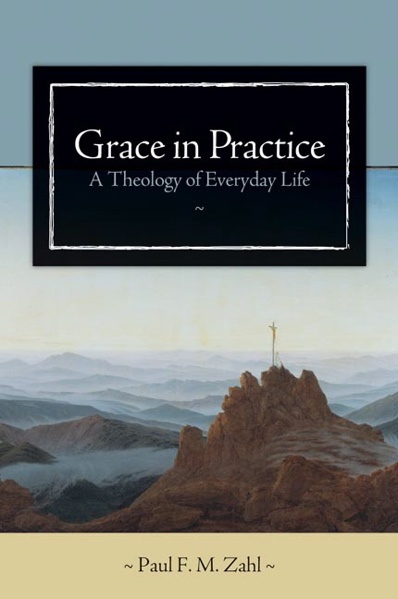Zahl, Paul F.M. Grace in Practice: A Theology of Everyday Life. Grand Rapids: Wm. B. Eerdmans Pub. Co., 2007.

Grace in Practice: A Theology of Everyday Life by Paul Zahl (book cover). The image is a link to wtsbooks.com for purchase.
Paul Zahl defines grace as “One-way love” (emphasis his).1 Self-consciously in dialogue with Luther and the Lutheran tradition, Zahl seeks to distinguish between law and this conception of grace. He believes that the law makes no exceptions and thus shows no mercy and that it cannot create the motivation to keep it. Worse the law “calls for perfection but stimulates rebellion.”2 However, grace, which comes from outside oneself, actually produces the fruits of love. Grace gives birth to grace. Indeed, Zahl says, “Grace is the chemistry of the new life, and law is the modus operandi of the old life.”3 The second chapter covers anthropology, soteriology, Christology, and the being of God. Regarding anthropology Zahl notes that grace must be one-way or human beings would be hopeless; that is, two-way love will never succeed because of original sin, total depravity, and the un-free will. Zahl realizes that the latter doctrine even encourages us to be less judgmental and more compassionate toward others. Believing in free will, by contrast, leads to judging and self-righteousness. After covering the other pillars of this practical theology, the rest of the book then applies the theme of grace to various spheres—family, society, church, everything—including addressing contemporary socio-political concerns. In sum, Zahl contends that grace works, whereas the law does not work.
Some parts of the book are better than others. The greatest weakness of this work is that he feels it necessary to dismiss the witness of Scriptures like Hebrews 10, James 2, and Second Peter 3:15-17 and to accuse several Old Testament prophets of semi-Pelagian heresy in order to consistently maintain his program of distinguishing law and grace. Zahl cannot reconcile such passages with what he sees as the overwhelming testimony of Scripture to the grace of God. In this respect, Zahl is still closely following Luther. On the other hand, Zahl abandons Luther’s two-kingdom approach to society in a way that seems unworkable (for example, no just war theory) although it opens up many interesting avenues of application that would be helpful in our relationships with one another and the surrounding world. He also only applies grace when there is still a place for law and the important thing for ministry is being able to distinguish which is needed in any given situation. It almost makes one wish that there was a political Party of Law and Grace in this coming election that could distinguish when law is appropriate and when grace is appropriate. Despite all of these weaknesses, among the strengths of Zahl’s foundational theological musings is the discussion on original sin, total depravity and the un-free will. One reason that section excels is the practical everyday way that Zahl explains these doctrines so that they are no longer conversations exclusively for those in ivory towers.
Perhaps the most important realization that a preacher can have in reading Zahl’s book is that whenever you ask people to do something in a sermon it is (usually or maybe always) heard as an attack – even a personal attack. This is because when the sermon gives application it is normally heard as law rather than as describing the fruits of grace. Law is never heard well. Zahl says, “Any judgment, any evaluation – even if it approves and speaks a blessing – will be heard as a negation” (emphasis his), and he further explains: “Law is an attack.”4 Zahn’s response would appear to be to avoid telling people to do something and instead simply preach grace and let that message do the rest. However, it might be more helpful to just acknowledge the problem with the way that we hear the application and encourage listening to gospel application as meant for forgiven and free people not under the condemnation of the law. Unfortunately Zahl is right that the typical three-point sermon outline today is to say what you need to do, say you are not doing it, and then tell the people to try harder. Unlike a message of grace, telling people to try harder does not work. However, it is worth noting that Zahl’s largest shortcoming in this book on speaking grace is to acknowledge when and how the preacher must speak a word of law before grace is heard as good news.
Zahl’s discussion concerning consumerism and the mall is also very helpful. He believes that grace rejects the mall. Sometimes the way that he describes the mall makes it sound like the law. For example, Zahl says, “The mall activates original sin and total depravity to a high degree” (emphasis his).5 Therefore, Zahl goes so far as to call for the opposition to “the construction of malls in every case” (emphasis his).6 Surely Zahl has gone too far, but the reason for such a hard line on malls is that Zahl understands the lure of the mall to people who struggle with an un-free will with material things. The memorable South Park episode “Something Wall-mart This Way Comes” that Zahl recalls is a great illustration of this power. Grace avoids the mall and resists commercialism. Perhaps helping one another to identify how the mall is like the law and how the mall judges us might lead us to seek the alternative – grace.
Even with all of the previous examples of how this book is helpful for ministry, the area where law and grace do the most damage and are integral to the life of a church is our personal relationships. Zahl says, “Every marriage, every romantic misfire, every point of trouble you have with a growing child, every resentment you store up against a parent, every argument you get into at work, every single possible site of tension in the relating to other people – these are all factors of law and grace in tension.”7 Here is where the real pay-off of the book is – as we reflect on the way that law and grace operate in our lives each and every day. The application is purposefully repetitive as Zahl notes that at each and every stage of marriage, for example, what is needed is grace.
An application from earlier in the book that hit closer to home for this reader was the example of emails. Truth be told it could also apply to writing things like this too. In any case, Zahl says that when you find yourself spending a lot of time writing and rewriting an email or looking for mistakes to correct in your emails then you must be writing to someone who “is a figure of the law in your life.” Zahl explains, “The person to whom you are writing has some kind of judging power, and it is this power that puts your e-mail under threat.” The issue is whether the email is written in response to grace or law.8 The very next example that Zahn uses is your wardrobe. Again using himself as an example, Zahl realizes that he usually does not give much consideration to what he wears but that when he does give it a lot of thought and second-guessing then that is the result of a similar response to law. These can be helpful diagnostic tools to discern what kind of relationship you have with the people involved. So while there may be plenty in this book to take issue with, including even in the discussion on relationships, it leaves the reader looking to Jesus for grace.
This was written for DM924: Theology for Ministry: Doctrine for Preaching and Pastoral Care, taught by Dr. Jonathan Linebaugh, Knox Theological Seminary

Recent Comments